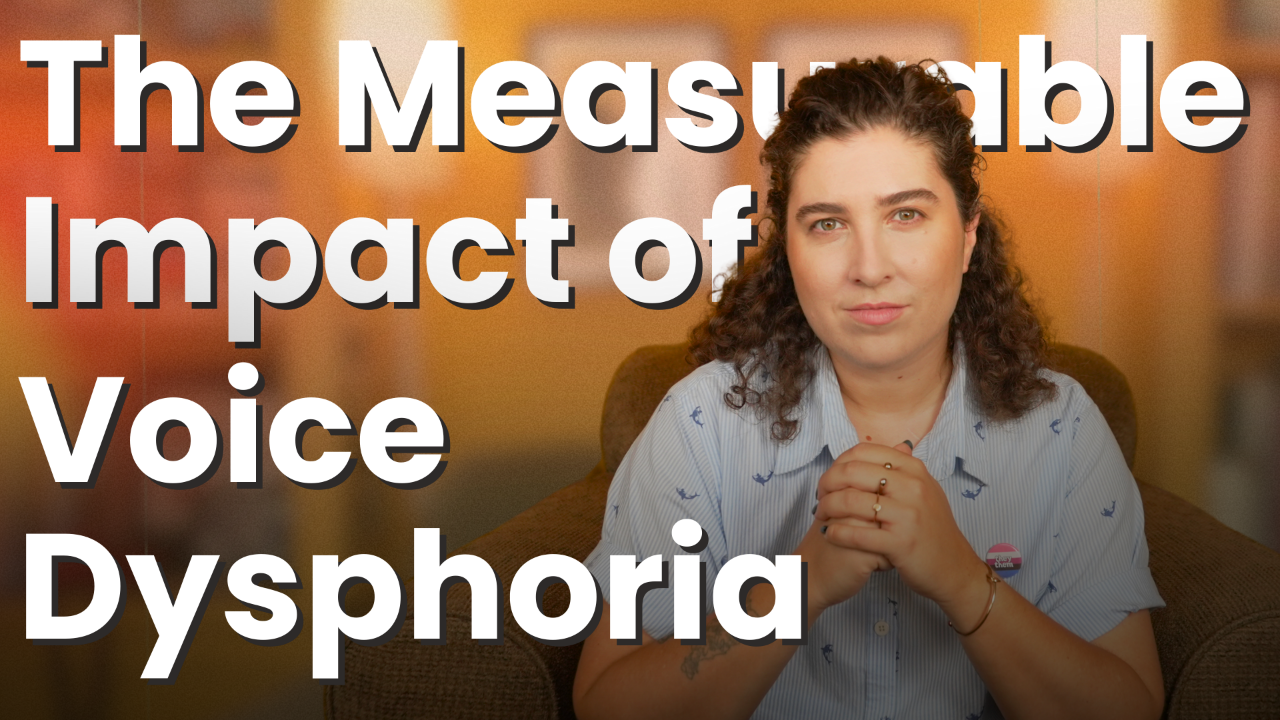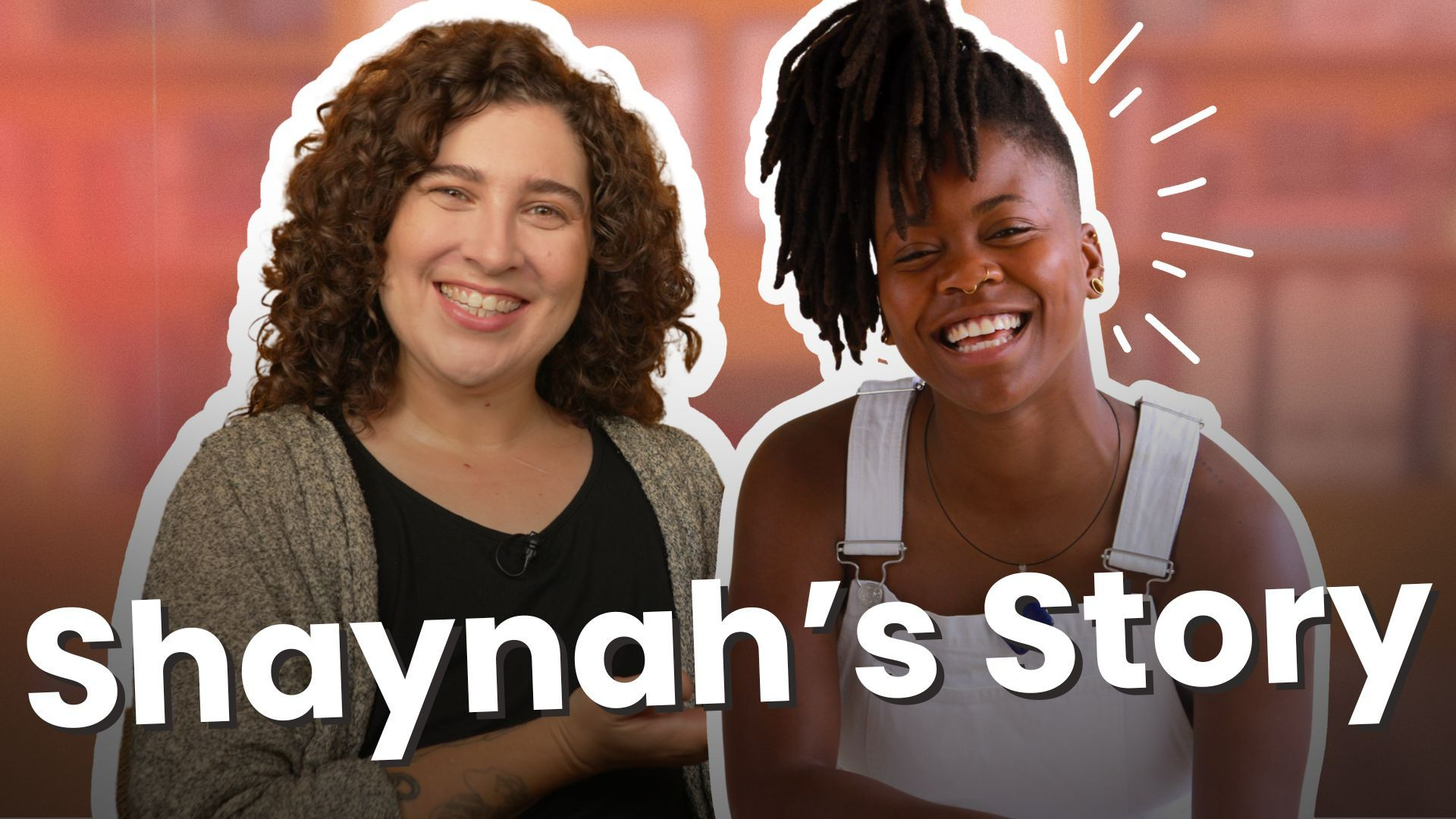Big Dog Little Dog with Rae from Origami Customs
Aug 17, 2023
Welcome, trans voice explorers! Today, I'm thrilled to share an insightful excerpt from a recent session with Rae, a dedicated student from my course Masculinize Your Voice Without Testosterone, as well as the founder of Origami Customs, a gender-affirming clothing brand out of Montreal that makes custom-sized gaffs and binders. Rae and I are friends in real life, and I asked them to show me how they do some of the exercises from the course they are in so that I could find ways to improve how I teach them.
Rae was kind enough to jump on camera with me so that we could all learn along with them.
Watch the video or read along with the transcript below:
Renée: So I wanted to just look at one exercise that you were talking to me about prior to this lesson, which was Big Dog, Little Dog, and I just wanted to see if we could optimize it a little bit. So do you think you would be comfortable showing me how you do the exercise now?
Rae: Yeah, totally. Can you model it for me first? Cause it's been a little while.
Renée: I don't want to, only because if I model it, you'll know exactly what it is, but I will explain.
Rae: Yeah, if you could give me some instructions.
Renée: Yes. Okay. So big dog, little dog is where you create the shape of the resonance you want by panting like either a little dog or a big dog. That's it. So let's just start by panting like a little dog. Can I see that?
(Rae pants like a little dog)
That's perfect. Great. Now can you show me your big dog pant?
(Rae pants like a big dog)
Okay. So this is exactly what I want to talk about. So when you are doing your big dog pant, we're hearing a little bit of phonation. Do you hear that when you do that?
Rae: Uh, can you explain more about what that is?
Renée: What phonation is? Phonation is sound through the larynx. So what I'm gonna have you do is take your hand and put it on your larynx.
And I just want you to go, (little pant) do you feel a little buzzing there?
Now go, (big pant) what does it feel like? Yeah, no, no buzzing. Now keep your hand there and do your little dog.
Rae: Okay, now I can feel the difference. Okay, yeah, a little bit.
Renée: Now try the big dog.
So this time you're trying not to phonate. So we don't actually hear the big dog anymore. It sounded similar to a little dog, right?
Rae: I'm concentrating on it too much.
Renée: Okay. We can put the hand down. So now I will model it for you and you're going to get it right, right away. Because imitation is what we need. So little dog, you don't need to move too much. Even let's try moving like less.
Rae: Yeah. But without the phonation.
Renée: The phonation of it. Exactly. Without the phonation. So you're making a really small shape and we can kind of hear how like bright it sounds. It kind of sounds glassy, maybe that's a word people just use to describe it, glassier sound. Now I want you to yawn a little bit. Do you feel the sensation of the movement in your larynx when you yawn? What do you feel?
Rae: Um, I feel it dropping, like I feel that openness. Yeah.
Renée: So we're going to do that. We're going to make a little bit of an open space. And actually, before we even do that, let's do one more little opening exercise. I want you to gasp on an ah vowel, like, ah, yeah, but without phonation. So we're just going to open.
Yeah. What does that feel like?
Rae: Um, yeah, I feel the larynx now that I know like where it is and how it moves down. It's the same as when I yawn.
Renée: Yeah. Exactly. The gasp and the yawn create the same action. And do you feel, I sometimes feel like a raising of the soft palate when I do this. Like it's like an opening in two directions.
Rae: Like a yawn. Yeah. Yeah. That makes sense.
Renée: So we're going to do that. We're going to gasp on that ah, and then we're going to try and hold that shape and do that panting like a big dog. So it's going to sound like this.
(Rae pants)
Much better, much better. So do you feel that time there was no phonation, right? Yeah. Great. So now let's take one sentence and we'll try and do it with the two shapes, the little dog shape and the big dog shape. This is going to be where it gets more challenging, obviously. So what's something you would say every day?
Rae: My name is Rae.
Renée: Beautiful. So we'll start with: My name is Rae. Now remember, we're going to gasp on that ah vowel.
Rae: Uh huh. My name is Rae.
Renée: Yeah, so it's a little bit harder for you to keep that down, right? We didn't get quite a distinct sound. So let's try exaggerating it. You're gonna yawn.
There we go. That's the shape I want you to try and hold.
Rae: My name is Rae.
Renée: There it is. Now one more time. Nice and confident. Exaggerated, yeah.
Rae: My name is Rae.
Renée: Very good. Now you're going to just relax the front of the face. You're using the face of like, I'm doing weird things with my mouth now. So let's just relax.
Rae: I'm going to say it like this when I actually introduce myself to people.
Renée: I mean, the yawn doesn't have to happen at the front of the mouth, right? You can keep your mouth almost closed. Like you're trying to stifle a yawn. Try to imagine that. Like, you can even see if I'm stifling a yawn, it's, you can still get the yawning shape, even with your mouth closed. So let's do that. We'll think of it as opening just in the back, and just relax the front of the face.
Rae: My name is Rae.
Renée: Good, now say it normally.
Rae: I don't have to say it like...
Renée: ...a big dog? Well, you can have the big dog shape, but if you were actually introducing yourself, what would that sound like?
Rae: My name is Rae.
Renée: Very good. Now let's just do one more thing just to see if it changes anything. You're gonna extend those vowels.
Rae: My name is Rae.
Renée: Just so you have a little more time to think. Yawn for me.
Rae: Yeah, good. My name is Rae.
Renée: Okay, that was a very different result than just the last one. Yeah. What was different? It sounded really different.
Rae: I think I just wasn't rushing through it and I could concentrate more on the vowel shape.
Renée: Okay, so let's just close the eyes, do it two more times at that speed, and then you can try and bring the speed up if you want. Go ahead. Okay.
Rae: My name is Rae.
Renée: Okay, a little more volume this time, just, just, just to see if that changes anything. Okay.
Rae: My name is Rae.
Renée: Okay, now say it if you were like, meeting someone, oh hi! Being an actual human. Yeah, go ahead.
Rae: My name is Rae.
Renée:Amazing!
Rae: Wait, open my eyes though, sorry. Yeah.
Renée: One more time with the eyes open.
Rae: My name is Rae.
Renée: Very good. So, tell me, like, how did this change your approach to the exercise, or I don't know, does it change anything in your practice, just knowing what you learned today?
Rae: Yeah, I mean absolutely. I think I wasn't quite getting that feeling to start with and now I still feel like I can slowly start to catch it.
I don't feel like I'm saying it naturally yet, but I think I need to practice it slowly, to get the muscle memory of like that opening beforehand. And it seems to click better when I can really like draw out the vowels. But it is a very different feeling and it's more towards what my target is. I can hear the sounds that I'm going for. And I think I just needed to like break it down and... Go farther back.
Renée: Great. Break it down. Go slower. Take the time to, like, digest each vowel, each shape, each sound. Yeah. I mean, anyone can do it, right? You're doing great. So thanks so much, Rae. Yeah.
Rae: That was awesome. Thank you.
Want weekly tips, resources, and insights on trans voice training? Sign up for my newsletter and get the latest content delivered straight to your inbox. It's free!









